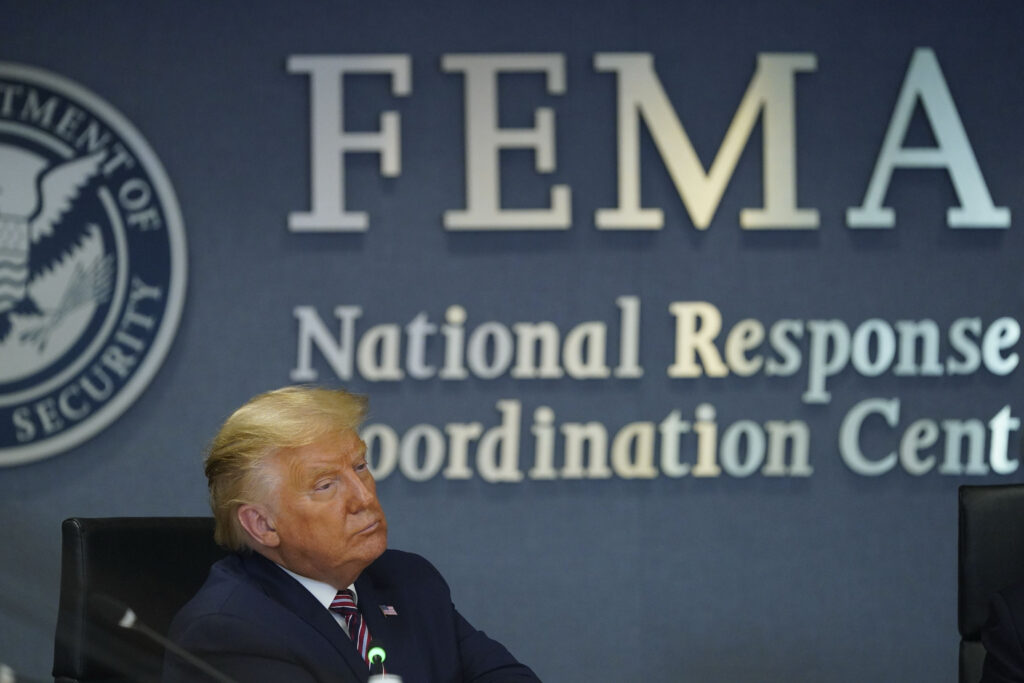A panel appointed by President Donald Trump to review whether to eliminate the Federal Emergency Management Agency has instead concluded in a report that the agency should be more powerful and autonomous. Homeland Security Secretary Kristi L. Noem, however, wants to take FEMA in a different direction.
The wrangling over the FEMA review council’s long-awaited report, which has been in the works for nearly 10 months, will help determine the fate of one of Trump’s controversial efforts to reshape the government and its ability to respond to disasters, such as floods, fires and hurricanes.
Noem, as the council co-chair, is responsible for finalizing the report and sending it to Trump for review. Her draft, which is not finished, recommends keeping FEMA within DHS and largely removing FEMA from its direct role in disaster relief, instead turning it into more of a grant-making operation, according to five people familiar with the situation who spoke on the condition of anonymity to discuss the private deliberations. The council’s earlier draft did not recommend those changes, but rather that FEMA gets elevated to a Cabinet-level office.
Noem’s office also wants to reduce the federal government’s share of disaster-related costs to 50 percent with states having to fund the other 50 percent with cash, which some council members staunchly opposed, according to a person familiar with the situation. Under current FEMA guidelines, the federal government covers about 75 percent of costs, and in extreme cases, will front nearly 100 percent for a period of time. The council is recommending FEMA keep its current cost share responsibility, which is defined by the Stafford Act.
A spokesperson for DHS denied Noem was trying to alter the report.
“Secretary Noem is the Chairwoman of the council and has worked with committee members collaboratively on the reform report,” DHS spokeswoman Tricia McLaughlin said in a statement. She said the council has “spent months working to provide recommendations to reshape and reform the bureaucratic mess that exists at FEMA.”
The negotiations over the report are still in flux, and the president’s final decision is not yet clear, according to people familiar with the process. Since he initially floated “reforming and overhauling FEMA — or maybe getting rid of FEMA” in January, Trump has met with first responders and victims’ families in disaster areas and heard from advisers and Republican officials who oppose eliminating the agency. The final report, which carries no legal weight but is a recommendation to the president for FEMA’s next steps, is expected in mid-December.
White House spokeswoman Abigail Jackson described the council’s mandate as recommending how to make sure “the federal role remains supplemental and appropriate to the scale of disaster.”
“Secretary Noem is working hard to implement the President’s vision that will best serve the American public,” Jackson said.
Trump, who has been highly critical of FEMA, appointed the council in part to address criticism of the way the federal government responds to natural disasters, according to people involved in the process. The 10-member council, led by Noem and co-chaired by Secretary of Defense Pete Hegseth, is composed of Republican state and local elected officials, a veteran FEMA official and an insurance CEO.
“When we first heard about the creation of this council, I think there were concerns that it would not do its due diligence,” said Pete Gaynor, who led FEMA for a time during Trump’s first administration. “But I think the council has done some pretty good work. I think they have made some positive recommendations on turning this thing from an overly complicated recovery process to something more simplified I think meets everyone’s goals.”
In early November, the council submitted a 160-page draft proposal on how to revamp FEMA and improve the country’s disaster response system — the result of about 13,000 public comments and about a dozen public and closed meetings with communities, many small and rural, from Puerto Rico to Louisiana to Wyoming to California.
The overarching conclusion aligned with Trump’s impulse to push more disaster-response capabilities and decisions to states. But the council, according to a person involved in the process and a review of meetings, became more focused on improving and elevating the agency, rather than shrinking or eliminating it.
“President Trump is putting Americans first by creating a once-in-a-lifetime opportunity to methodically align and strengthen how emergency management is integrated across all levels of government,” Kevin Guthrie, Florida’s director of emergency management, said during an August FEMA review council meeting in Oklahoma City. “We don’t get an opportunity to hit the reset button often, and we’ve been given that opportunity through this committee.”
Some of the council’s detailed suggestions include making it easier for disaster-stricken residents and communities to get FEMA’s Individual and Public Assistance funds by accelerating the dispersal of funding to the communities and reforming how FEMA manages the National Flood Insurance Program, according to three people familiar with the report and a copy of its table of contents. It also proposed moving FEMA out of the Department of Homeland Security and making it a cabinet-level department.
But after the report’s submission, Noem and her top adviser, former Trump campaign manager Corey Lewandowski, cut the draft proposal to fewer than 20 pages, while keeping open the possibility of releasing the rest as supplemental material, officials said. Some White House officials received a copy of the council’s unedited draft, according to two people familiar with the matter.
“It’s like Edward Scissorhands,” a person familiar with the situation said of Noem’s edited version of the report. “She wants to chop it up, and decentralize and really drastically limit FEMA. Many members on the council are not happy with how she has put her thumb on the scale.”
Noem’s revisions also include a recommendation to further cut FEMA staff by about half and have FEMA only handle debris removal and emergency protective measures when responding to a disaster, moving most of its other work — such as helping repair damaged utilities, roads and bridges, public buildings and parks — to other agencies, according to a person familiar with the reports. In addition, about a month ago, Noem announced a desire to relocate FEMA’s headquarters from Washington D.C. to Texas, which Politico first reported.
Those ideas concerned some experts on the council who warned that state and local governments lack the resources to take over those responsibilities from FEMA and that the changes needed to be phased in to give states and local communities time to shift their budgets to better support their own emergency management capabilities.
After Trump commissioned the council through an executive order in January, the administration had largely pinned FEMA’s future on what the council would suggest.
The members took that mission seriously, according to people familiar with the process. While it was clear to some that Trump and Noem both desired to get rid of FEMA as it exists today, members of the council spent months sifting through feedback from all corners of the U.S., including tribes who often struggle to get federal disaster assistance, and determined that FEMA needed to make its programs more accessible to rural regions, according to people familiar with the report. The council also highlighted the need to mitigate risk by enabling communities to rebuild more safely, they said.
That effort, one person said, created some tension between some council members and Noem and Lewandowski, who would often come into their meetings and interject his thoughts.
One example is Noem’s proposal to move FEMA to Texas, and potentially tap Nim Kidd, the head of the Texas Division of Emergency Management and a member of the council, to lead the agency. She argued that relocating the agency’s headquarters was one of Trump’s desires, according to two people with knowledge of the situation, who added that some members of the council were shocked by the proposal.
That shift had not been something the council was discussing, and relocating much of the agency’s operations out West seemed counterintuitive to the council’s goal of enabling FEMA to operate more efficiently and nimbly when responding to disasters across the U.S., those people said. White House officials told some council members that the relocation was not one of Trump’s priorities.
Transferring much of the agency’s operations nearly across the country would make it much harder to coordinate a federal emergency response, experts and current and former officials said, especially since one of FEMA’s key responsibilities is ensuring that the executive branch can function during a national emergency, such as a terrorist attack, and overseeing national emergency communication systems.
For the last few months, there has been speculation as to whether Noem would accept the council’s outline for the future of FEMA and thus the nation’s disaster response framework.
At the National Emergency Management Association’s conference last month, Guthrie, the Florida emergency management director, took the podium to address attendees, telling them about the much awaited council report. Cameron Hamilton, FEMA’s former acting administrator whom Noem fired this spring for going against her desire to eliminate the agency, then asked him a blunt question: “What degree of confidence do you have that [the] report that you submit to DHS will be what is submitted to the president?”
“[Guthrie] sighed,” Hamilton recalled. “He said he feels confident in the report that they will submit to the Secretary. And that’s where he stopped.”
Greg Schneider contributed reporting.
The post Noem at odds with Trump-appointed panel over future of FEMA appeared first on Washington Post.




